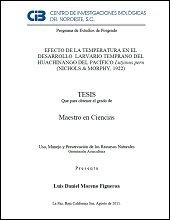| dc.contributor | MINERVA CONCEPCION MALDONADO GARCIA | |
| dc.creator | LUIS DANIEL MORENO FIGUEROA | |
| dc.date | 2011-08-31 | |
| dc.identifier | http://cibnor.repositorioinstitucional.mx/jspui/handle/1001/229 | |
| dc.identifier.uri | http://dspace.cibnor.mx:8080/handle/123456789/2503 | |
| dc.description | Uno de los principales problemas que se ha presentado dentro del cultivo de peces marinos es la alta mortalidad en estadios tempranos larvarios. Dentro de este contexto, la temperatura toma un papel fundamental en el desarrollo larvario, la cual se ha reportado tiene una influencia directa en el crecimiento y supervivencia de las larvas. Así mismo, la temperatura del agua influye en el porcentaje de eclosión, el tamaño larval al momento de la eclosión, el tiempo de absorción del saco vitelino y la eficiencia en el uso de las reservas energéticas. El objetivo del presente trabajo fue evaluar el efecto de la temperatura sobre el porcentaje de eclosión, eficiencia en la absorción de las reservas energéticas, desarrollo del sistema digestivo y ocular, así como la supervivencia de larvas de huachinango del Pacífico Lutjanus peru, durante los primeros días de vida, con la finalidad de optimizar las condiciones de incubación de los huevos y larvas con vitelo. Para este experimento se utilizaron huevos obtenidos de manera natural a partir de reproductores mantenidos en cautiverio de Lutjanus peru. Los huevos y larvas fueron sometidos a diez temperaturas experimentales: 10, 13, 16, 20, 23, 26, 29, 32, 35 y 38°C con 3 réplicas para cada tratamiento a una densidad de 100 huevos/L. Los parámetros de respuesta del presente experimento se inician con la evaluación del porcentaje de eclosión larval; a su vez las medidas morfométricas se realizaron a partir de imágenes de larvas vivas evaluando: longitud notocordal (LN), longitud del saco vitelino (LSV), ancho del saco vitelino (ASV) y diámetro de la gota de aceite (DGA). Además, se realizó una descripción larvaria partiendo desde el estadio huevo hasta la etapa de absorción completa del vitelo y gota de aceite para todos los tratamientos experimentales. A los resultados de las medidas morfométricas se les aplicó un análisis de varianza (ANOVA) de un factor, considerando un intervalo de confianza del 95%. Los resultados obtenidos mostraron un mayor porcentaje de eclosión (90-95%) para las temperaturas a 20, 23, 26, 29 y 32oC que para las demás temperaturas experimentales; encontrándose diferencias significativas (P<0.05) entre los diferentes tratamientos: 10oC (0%), 13oC (10%), 16oC (46%), 35oC (30%), 38oC (0%) [...] | |
| dc.description | One of the main problems marine aquaculture has faced is the high mortality at larval stage. Inside this context, temperature takes an important role because it is been reported has a direct influence in the growth and survival on larvae. Likewise, water temperature influences on the hatching rate, larval size at hatch moment, the absorption time of the yolk sac and oil globule and the efficiency in the use of energetic reserves. The objective of this study was to evaluate the temperature effect in the hatching rate, absorption efficiency of energetic reserves, digestive and ocular system development and the survival of red snapper Lutjanus peru on the first days of life, with the purpose of optimize the incubation conditions of eggs and larvae. The eggs used in this experiment were obtained from natural spawns carried out by a Lutjanus peru broodstock maintain in captivity. The eggs and larvae were maintained under ten experimental temperatures: 10, 13, 16, 20, 23, 26, 29, 32, 35 and 38°C with three replics for each treatment with a 100 eggs/L density. The response parameters for this study initiated with the hatching rate evaluation, in turn the morphometric measurements were made from images of live larvae for evaluation: standard length (LS), yolk sac length (LSV), yolk sac height (ASV) and the oil globule diameter. In addition a larvae description was made from the egg stage to the complete yolk sac and oil globule absorption stage for all treatments. The results of morphometric measurements were submitted by an analysis of variance (ANOVA) of one factor, considering a confidence interval of 95%. The results obtained in this study showed a major hatching rate (90-95%) for temperatures 20, 23, 26, 29 and 32°C than the others experimental temperatures; being significant differences (P<0.05) between the experimental treatments: 10oC (0%), 13oC (10%), 16oC (46%), 35oC (30%), 38oC (0%) [...] | |
| dc.format | application/pdf | |
| dc.language | spa | |
| dc.publisher | Centro de Investigaciones Biológicas del Noroeste, S.C. | |
| dc.rights | info:eu-repo/semantics/openAccess | |
| dc.rights | http://creativecommons.org/licenses/by-nc-nd/4.0 | |
| dc.subject | info:eu-repo/classification/AUTOR/desarrollo larval; temperatura; huachinango del Pacífico | |
| dc.subject | info:eu-repo/classification/cti/1 | |
| dc.subject | info:eu-repo/classification/cti/25 | |
| dc.subject | info:eu-repo/classification/cti/2510 | |
| dc.subject | info:eu-repo/classification/cti/251092 | |
| dc.subject | info:eu-repo/classification/cti/251092 | |
| dc.title | Efecto de la temperatura en el desarrollo larvario temprano del huachinango del Pacífico Lutjanus peru (Nichols and Morphy, 1922) | |
| dc.type | info:eu-repo/semantics/masterThesis | |


